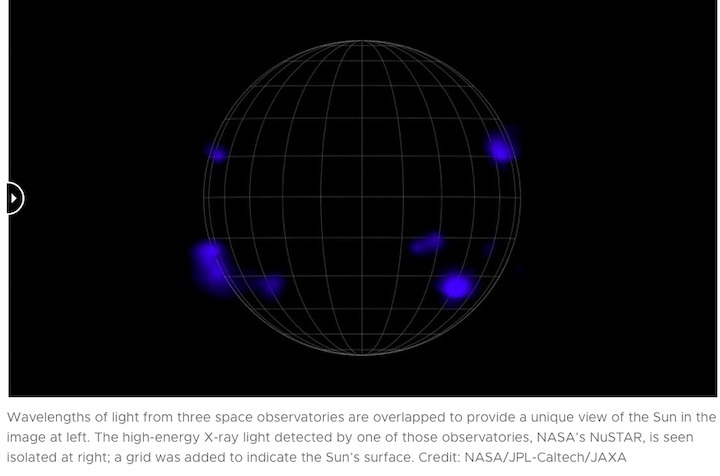11.02.2023
Some of the hottest spots in the Sun’s atmosphere appear in the telescope’s X-ray view.


Even on a sunny day, human eyes can’t see all the light our nearest star gives off. A new image displays some of this hidden light, including the high-energy X-rays emitted by the hottest material in the Sun’s atmosphere, as observed by NASA’s Nuclear Spectroscopic Telescope Array (NuSTAR). While the observatory typically studies objects outside our solar system – like massive black holes and collapsed stars – it has also provided astronomers with insights about our Sun.
In the composite image above (left), NuSTAR data is represented as blue and is overlaid with observations by the X-ray Telescope (XRT) on the Japanese Aerospace Exploration Agency’s Hinode mission, represented as green, and the Atmospheric Imaging Assembly (AIA) on NASA’s Solar Dynamics Observatory (SDO), represented as red. NuSTAR’s relatively small field of view means it can’t see the entire Sun from its position in Earth orbit, so the observatory’s view of the Sun is actually a mosaic of 25 images, taken in June 2022.
The high-energy X-rays observed by NuSTAR appear at only a few locations in the Sun’s atmosphere. By contrast, Hinode’s XRT detects low-energy X-rays, and SDO’s AIA detects ultraviolet light – wavelengths that are emitted across the entire face of the Sun.

The Sun appears different depending on who’s looking. From left, NASA’s NuSTAR sees high-energy X-rays; the Japanese Aerospace Exploration Agency’s Hinode mission sees lower energy X-rays; and NASA’s Solar Dynamics Observatory sees ultraviolet light.
Credit: NASA/JPL-Caltech/JAXA
NuSTAR’s view could help scientists solve one of the biggest mysteries about our nearest star: why the Sun’s outer atmosphere, called the corona, reaches more than a million degrees – at least 100 times hotter than its surface. This has puzzled scientists because the Sun’s heat originates in its core and travels outward. It’s as if the air around a fire were 100 times hotter than the flames.
The source of the corona’s heat could be small eruptions in the Sun’s atmosphere called nanoflares. Flares are large outbursts of heat, light, and particles visible to a wide range of solar observatories. Nanoflares are much smaller events, but both types produce material even hotter than the average temperature of the corona. Regular flares don’t happen often enough to keep the corona at the high temperatures scientists observe, but nanoflares may occur much more frequently – perhaps often enough that they collectively heat the corona.
Although individual nanoflares are too faint to observe amid the Sun’s blazing light, NuSTAR can detect light from the high-temperature material thought to be produced when a large number of nanoflares occur close to one another. This ability enables physicists to investigate how frequently nanoflares occur and how they release energy.
Quelle: NASA
